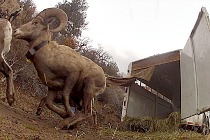The Oregon Department of Fish and Wildlife captured and relocated California bighorn sheep at several locations this week to improve genetic diversity among herds and continue efforts to restore this native species in Oregon.
Bighorns were captured in the Deschutes and John Day River canyons and in the Branson Creek area of Grant County. Fifteen sheep captured in the Deschutes River Canyon were released at Alvord Peaks (Harney County) and 20 sheep captured in the John Day River Canyon went to McClellan (Grant County).

PHOTO COURTESY OF ODFW
“Research conducted in Oregon shows we need to mix up the genetics of the herds,” said Don Whittaker, ODFW ungulate coordinator. “Higher genetic diversity leads to better population performance and we hope to see population increases, too.”
During the capture operations this week, a helicopter was used to locate sheep before they were captured using a net fired out of the helicopter from a specially-designed gun. Once captured, the sheep were blindfolded and restrained to calm them, then hoisted in the air by the helicopter and taken to a location where ODFW biologists and veterinarians processed the animals. Each bighorn sheep was disease-tested and many were fitted with a transmitter so their movements can be tracked.
Twenty bighorn sheep were also released on Bureau of Land Management land in the Klamath River Canyon (below JC Boyle Dam) today, where bighorn sheep have not been seen since they were extirpated from Oregon in the 1940s. Most of these were from the Branson Creek area of Grant County. Wildlife managers removed all sheep from Branson Creek during this week’s operation because domestic sheep also graze in parts of this area, and there is a risk of disease transmission between wild and domestic sheep. Additional sheep captured in Branson Creek may be released in the Klamath River Canyon tomorrow.
Historically, California bighorns were the most abundant native wild sheep in Oregon and were found throughout the mountainous terrain of southeast Oregon. This week’s operations are part of continuing efforts to restore the species to its native range.
“These magnificent animals are an iconic species in southeast Oregon’s mountain country,” said Tom Collom, district wildlife biologist in Klamath Falls. “This week’s operation will help maintain healthy herds of bighorn sheep and continue the state’s restoration efforts, which have been in the works since the 1950s.”
Several sheep released have GPS collars which will allow ODFW to closely monitor their location. Periodic aerial and ground surveys are also planned.
Bighorn sheep live in rugged country but rafters along the Klamath River may catch a glimpse of the sheep.
Bighorn sheep died off in Oregon in the 1940s due to unregulated hunting and their susceptibility to domestic livestock diseases. The first successful bighorn sheep relocation in Oregon occurred in 1954, when 20 California bighorns were relocated from British Columbia to the Hart Mountain National Antelope Refuge in Lake County. Since then, the population of bighorn sheep has grown to an estimated 3,500-3,700 as a result of ODFW’s aggressive restoration efforts.
Next week, ODFW will conduct additional collaring of Rocky Mountain bighorn sheep in the Lower Imnaha River area to help wildlife managers better monitor herds in Northeast Oregon.
Bighorn sheep are one of the rarest game mammals in Oregon today. Less than 100 bighorn sheep tags were offered to hunters last year on a “once-in-a-lifetime” hunt basis. ODFW also auctions and raffles off a bighorn sheep tag each year at events sponsored by sportsmen conservation groups; proceeds from the sales benefit the management of bighorn sheep.
About 800 Rocky Mountain bighorn sheep live in the mountains and canyons of Northeastern Oregon; the rest of the animals in the state are California bighorn sheep. ODFW generally relocates 20-80 bighorn sheep annually with the ultimate goal of creating healthy bighorn sheep populations in all available, suitable habitats within Oregon.










